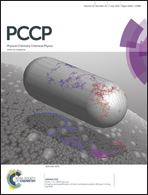Conformational studies of poly(vinylidene fluoride), poly(trifluoroethylene) and poly(vinylidene fluoride-co-trifluoroethylene) using density functional theory
Abstract
Different conformations of systems consisting of poly(vinylidene fluoride) (PVDF), poly(trifluoroethylene) (PTrFE) and poly(vinylidene fluoride-co-trifluoroethylene) (P(VDF-TrFE)) were investigated using density functional theory with dispersion correction. It was found that the trans-gauche–trans-gauche′ (TGTG′) conformation of a single PVDF chain is the lowest energy conformer. Crystals of PVDF were modelled using between two to five chains with up to 12 repeat units in each chain and, in agreement with experiment, structures comprised partly or completely of chains with the TGTG′ conformation are more stable than structures built up from chains with all-trans (TTTT) conformation. This indicates that an all-trans segment or chain will not induce the growth of a larger crystal with the same chain conformations. In contrast, the energetically preferred structure of PTrFE chains is an all-trans (TTTT) conformation, and the results indicate that copolymerization of vinylidene fluoride with trifluoroethylene can facilitate the formation of the all-trans PVDF conformations. This is probably due to increased intramolecular repulsion between the fluorine atoms and an increased intermolecular attraction in the crystal structure.


 Please wait while we load your content...
Please wait while we load your content...